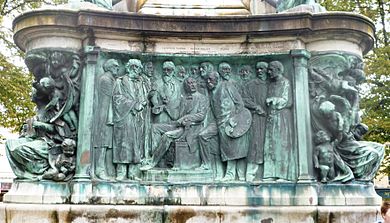Queen Victoria Memorial, Lancaster facts for kids

South aspect
|
|
| Coordinates | 54°02′52″N 2°47′52″W / 54.0478°N 2.7977°W |
|---|---|
| Location | Dalton Square, Lancaster, Lancashire |
| Designer | Herbert Hampton |
| Type | Monument |
| Material | Stone and bronze |
| Opening date | 1906 |
| Dedicated to | "Given to his native town by Lord Ashton" |
|
Listed Building – Grade II*
|
|
| Designated: | 18 February 1970 |
| Reference #: | 1290440 |
The Queen Victoria Memorial is a special monument in Lancaster, Lancashire, England. It's like an important historical building, called a Grade II* listed building. You can find it right in the middle of Dalton Square, facing the Lancaster Town Hall. This memorial was built in 1906. A wealthy man named James Williamson, 1st Baron Ashton paid for it to be made for his hometown.
The monument was designed by Herbert Hampton, a very busy sculptor. He also designed parts of another famous building in Lancaster, the Ashton Memorial.
Contents
Discover the Queen Victoria Memorial
The Queen Victoria Memorial is made from Portland stone and has amazing bronze sculptures. A large statue of Queen Victoria stands on a tall base, looking out over the square. Someone once said she looks "a little pensively," which means a bit thoughtful or serious.
What the Memorial Looks Like
The tall base of the monument has a square shape with rounded corners. Around it, you'll see four bronze lions, one at each main direction (north, east, south, west).
Around the base, there's a long, detailed bronze picture called a bas relief frieze. At each corner, there are four special sculptures. These sculptures represent important ideas:
- Freedom (northeast)
- Truth (southeast)
- Wisdom (southwest)
- Justice (northwest)
On the four main sides of the base, there are nearly life-sized pictures of 53 important British people from the Victorian era. This was the time when Queen Victoria was queen.
Famous Faces on the Monument
Out of the 53 people shown on the monument, only two are women: George Eliot (a famous writer) and Florence Nightingale (a famous nurse).
Some of the people shown were born right in Lancaster or nearby. These include William Turner, Edward Frankland, Richard Owen, William Whewell, and James Williamson, 1st Baron Ashton himself, who paid for the monument.
When the monument was built, six of the people shown were still alive! These were William Turner, Luke Fildes, Lord Lister (a famous surgeon), Lord Kelvin (a brilliant scientist), Florence Nightingale, and James Williamson, 1st Baron Ashton.
Locally, some people in Lancaster jokingly call the monument "King Victoria." This is because of how the statue looks like a king's silhouette against the sunset sky.
Gallery
Art and Culture on the East Side
The east side of the monument shows thirteen important Victorians from the world of arts and culture. Some of these include:
- Sir Henry Irving: A famous actor.
- Alfred, Lord Tennyson: A well-known poet.
- Sir Arthur Sullivan: A composer and conductor.
- J. M. W. Turner: A brilliant painter.
- Albert, Prince Consort: Queen Victoria's husband.
- John Ruskin: An art critic and writer.
- John Everett Millais: A famous painter.
- Luke Fildes: An illustrator and painter.
Leaders and Politicians on the South Side
The south side of the monument features twelve Victorian politicians and leaders. These are people who helped run the country. Some of them were:
- Edward Smith-Stanley, 14th Earl of Derby: A Prime Minister.
- Sir Robert Peel: Another Prime Minister.
- Benjamin Disraeli: A Prime Minister and novelist.
- William Ewart Gladstone: A very famous Prime Minister.
- Lord Palmerston: Also a Prime Minister.
- John Bright: An important politician.
Scientists and Writers on the West Side
The west side of the monument shows fourteen Victorian scientists and writers. These are people who made big discoveries or wrote important books. Some of them are:
- Sir William Turner: An anatomist.
- Lord Lister: A surgeon who changed medicine with antiseptic surgery.
- Edward Frankland: A chemist.
- Richard Owen: A scientist who studied animals and fossils.
- Charles Darwin: Famous for his theory of natural selection.
- Charles Dickens: A very popular novelist.
- George Eliot: A famous female novelist.
- George Stephenson: A civil engineer, known for railways.
- Lord Kelvin: A brilliant mathematician and physicist.
- Michael Faraday: A famous scientist.
Diverse Figures on the North Side
The north side of the monument has a mix of important people from Victorian times. These include:
- Isaac Pitman: Who invented shorthand writing.
- William Whewell: A writer on science and philosophy.
- Florence Nightingale: The famous nurse who reformed nursing.
- John Franklin: A naval officer and explorer of the Arctic.
- David Livingstone: A famous explorer and missionary.
- William Booth: The founder of the Salvation Army.
- Lord Shaftesbury: A philanthropist who helped many people.
- Rowland Hill: Who reformed the postal service.
- James Williamson, 1st Baron Ashton: The man who paid for the monument!
Looking After the Memorial
The Queen Victoria Memorial was given its special Grade II* listed building status in 1970. This means it's a very important historical structure that needs to be protected.
In 2012, a group called English Heritage (now Historic England) said the monument was at risk. The bronze parts were turning green and wearing away, and the stone was getting stained and sometimes had graffiti. Because of this, it was put on a list called "Heritage at Risk."
In 2014, the Lancaster City Council announced they wanted to fix up the monument. They hoped to raise money from people or private groups to help restore it to its former glory.










